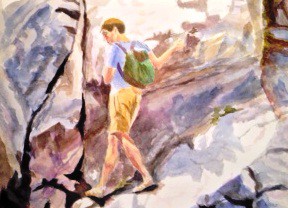 Edward Ravine is a practicing psychotherapist, local painter, and the next featured artist in our ongoing exhibition series Local Art @ EPL. His show – Live Life Like a River – is currently on display on the 2nd floor of EPL’s Main Library where you can catch it through May 31st. Representing 15 years of artistic study under Leslie Hirshfield at the Noyes Cultural Arts Center, Ravine’s striking watercolors capture his quiet moments spent in the peace of wild places like Utah’s Big Cottonwood Canyon and Glencoe’s Skokie Lagoons. We recently spoke with him via email about how the Vietnam War influenced his art, Winslow Homer, his forthcoming book, and his need for time in the wilderness.
Edward Ravine is a practicing psychotherapist, local painter, and the next featured artist in our ongoing exhibition series Local Art @ EPL. His show – Live Life Like a River – is currently on display on the 2nd floor of EPL’s Main Library where you can catch it through May 31st. Representing 15 years of artistic study under Leslie Hirshfield at the Noyes Cultural Arts Center, Ravine’s striking watercolors capture his quiet moments spent in the peace of wild places like Utah’s Big Cottonwood Canyon and Glencoe’s Skokie Lagoons. We recently spoke with him via email about how the Vietnam War influenced his art, Winslow Homer, his forthcoming book, and his need for time in the wilderness.
Evanston Public Library: Can you tell us a little about your background as an artist? How did you get started in art? Was there something specific in your life that sparked a need to create? What drove you in the beginning? What drives you now?
Ed Ravine: As a young man I served state side as a medical worker with returning injured Vietnam veterans. I was a non-combatant medic with conscientious objector status. This created a humility about quietly being a person who served others. None of that work was about me; it was about those who were wounded. My artwork since age 50 – I am 66 now – is about being a respectful observer. You learn something from each painting, much the way you learn something new from each person you meet. Being clear and open are important to me at this age. Replacing sorrow with kindness and fear with love is my mantra.
 EPL: How do you describe your art? Do you see yourself as fitting in with any particular artistic movements or styles?
EPL: How do you describe your art? Do you see yourself as fitting in with any particular artistic movements or styles?
ER: I am a neo-Winslow Homerist. Homer created an American art that was extraordinary. From his exposure to the Civil War by being an embedded reporter for Harpers Weekly, he had a unique self-taught vision. He was simple, natural, and his scenes take us to places we can admire while renewing ourselves. I aspire to examine the simple beauty around us in the American landscape. So far it’s been a great adventure to see how my art interprets what I see in Utah, Colorado, Michigan and Maine. Like Homer, I was sensitized to creativity by the horrors of war.
EPL: Can you give us a window into your creative process? When and where do you work?
ER: Things catch my eye: water, a mountain hiking path, the coast of Maine. I work fast and finish fast, usually in 6 hours. Watercolor is hard, it flows chaotically. I do a lot of layering called “glazing.” My pallet has three colors: a quadrone gold, various purples, and greens. I work in Leslie Hirshfield’s studio, at home, and outside.
 EPL: What are your future goals and plans as an artist?
EPL: What are your future goals and plans as an artist?
ER: Do more outside, en plein air. Do large oils to capture more exactly the natural landscapes that catch my eye. I need more time in the wilderness, to heal a lifetime of serving veterans and others with trauma. I’d like to hike the Appalachian Trail and paint as I go. It would be a visual journal, and I am working on a book titled “The Effects of War on the American Artist.”
EPL: How do you find Evanston and the Chicagoland area as a place to work and exhibit as an artist? What inspires you as an artist about the community where you live?
ER: Evanston and Chicago are great, wholehearted places to live. The sunrises on Lake Michigan alone are exemplary. Likewise, the Art Institute, the MCA, and more recently the Block Gallery at Northwestern really do influence and inspire my work. Likewise my wonderful family and friends encourage me to go deep, keep active, and view my life as a great adventure. I am blessed.
Interview by Russell J.
